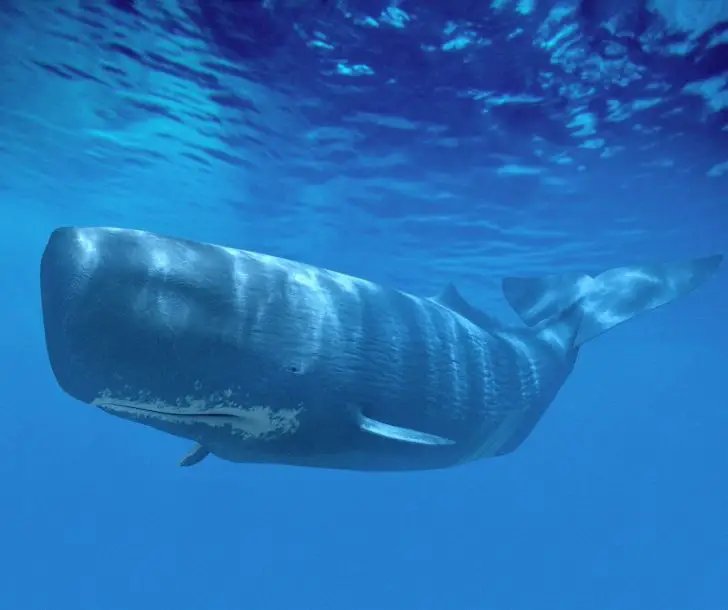
Think of the sperm whale as the wise old man of the sea, holding secrets of the underwater world. They are remarkable not just for their physical capabilities, but also for their social structures, hunting strategies, and even their emotional depths. So, grab a cup of coffee, sit back, and let’s dive into ten cool things you probably didn’t know about these oceanic giants.
1. They Have the Largest Brain of Any Animal
Here’s the thing: when it comes to brain size, sperm whales are at the top of the list. Their brains can weigh up to 20 pounds, which is about six times heavier than a human brain. But size doesn’t always equal intelligence. That said, the large brain is believed to play a role in their complex social behaviors and communication skills.
You might be wondering how scientists understand whale intelligence. They often study their social interactions and problem-solving abilities. Sperm whales have been observed using sophisticated hunting techniques and even working together to protect their young. This indicates a level of awareness and social intelligence that’s fascinating to explore.
2. They Can Hold Their Breath for Over an Hour
Imagine holding your breath for more than an hour! Sperm whales have the incredible ability to do just that. These majestic creatures can dive to depths of over 10,000 feet in search of squid, their primary food source, and can stay submerged for up to 90 minutes.
What enables them to do this? Their bodies are specially adapted to manage oxygen efficiently. They have large lungs and a high concentration of myoglobin in their muscles, which helps store oxygen. Plus, their heart rate slows down significantly during deep dives, allowing them to conserve oxygen while they’re below the surface. It’s like having a built-in oxygen tank!
3. They Communicate in Complex Ways
Communication among sperm whales is nothing short of fascinating. They use a variety of sounds, such as clicks and whistles, to communicate with one another. These sounds can travel long distances underwater, making it easier for them to stay connected even when separated by miles.
Interestingly, research has shown that these clicks can vary between regions, almost like distinct dialects. This variation suggests that sperm whales have a rich social life and culture that is just waiting to be explored. They also use echolocation to hunt, sending out clicks and listening for the echoes, much like how a bat navigates in the dark.
4. They Have a Unique Social Structure
Sperm whales are social creatures, and their family dynamics are quite unique. They live in groups called pods, usually consisting of females and their young, while the adult males often go solo or form bachelor groups.
The females are known to be highly nurturing and protective of their calves. In fact, they often stay with their mothers for years, learning essential survival skills. The social bonds within these pods are strong, and they rely on each other for protection against predators like orcas, which are one of the few known threats to adult sperm whales.
5. They’re Named for Their Unique Spermaceti Organ
You might find the name “sperm whale” a bit odd, but it actually references a unique organ known as the spermaceti organ. Located in their heads, this organ is filled with a waxy substance called spermaceti, which helps in buoyancy control and echolocation.
When sperm whales dive, the spermaceti can change in consistency based on temperature and pressure, allowing them to maneuver more easily. It’s fascinating to think about how this special adaptation aids them in their underwater adventures. Plus, this substance was highly sought after in the past for use in candles and cosmetics, adding an interesting layer to their history.
6. They Can Dive to Incredible Depths
As mentioned earlier, sperm whales are champions when it comes to diving. They’re known for reaching astonishing depths, often exceeding 10,000 feet. At these depths, the pressure is immense, and their bodies are perfectly adapted to handle such conditions.
The unique structure of their lungs allows for collapsible ribs that prevent lung damage during deep dives. You might picture them gliding gracefully through the dark, pressure-filled waters, searching for squid in an environment where light hardly penetrates. Their adaptability in such challenging conditions is a testament to how incredible these animals are.
7. They Have a Unique Feeding Technique
Sperm whales are like the ninjas of the ocean when it comes to hunting. They primarily feed on giant squid, and their feeding strategy is both fascinating and effective. Using echolocation, they locate their prey in the dark depths of the ocean.
Once they’ve found their target, they can dive and use their bulk to capture it. They often swallow their prey whole, making them some of the ocean’s most efficient hunters. Some researchers believe that the whales’ social structures even play a role in hunting, with pods working together to drive squids into a smaller space.
8. They Can Live for Over 70 Years
Like fine wine, sperm whales get better with age. They can live up to 70 years or more, making them one of the longer-lived species in the animal kingdom. Their longevity allows them to accumulate a wealth of knowledge and experience—it’s almost like they have an oceanic wisdom about them.
Older females, in particular, often serve as leaders within pods, guiding younger whales and passing down important survival skills. This intergenerational knowledge contributes to the strong social bonds seen in these whales and the overall health of their populations.
9. They’re Endangered but Protected
Sadly, sperm whales face numerous threats due to human activities, such as whaling, pollution, and climate change. Commercial whaling significantly reduced their populations in the past, leading to their current status as a protected species under various international agreements.
Organizations and governments are working hard to conserve their populations and habitats. Protecting marine environments, reducing pollution, and promoting sustainable practices are essential to ensuring that future generations can enjoy and learn about these incredible creatures.
10. They May Have Emotional Depths
Last but not least, there’s growing evidence suggesting that sperm whales may have emotional capacities similar to many mammals. Observations of their behavior indicate that they form deep bonds with their pods and display signs of grief when a member passes away.
This emotional complexity adds another layer to our understanding of these magnificent beings. It’s a reminder that here in the ocean, beneath the waves, there are rich lives and feelings that deserve our respect and protection.
As you can see, sperm whales are not just big fish in the sea; they’re complex beings with fascinating lives. Whether it’s their impressive brain size, unique social structures, or their ability to dive deep into the unknown, these gentle giants have captivated our curiosity for centuries. Hopefully, this peek into their world has shed some light on just how incredible these whales truly are. Let’s continue to learn about and protect these magnificent creatures for generations to come!

